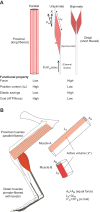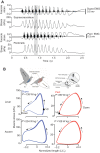Locomotion as an emergent property of muscle contractile dynamics
- PMID: 26792341
- PMCID: PMC6514473
- DOI: 10.1242/jeb.123935
Locomotion as an emergent property of muscle contractile dynamics
Abstract
Skeletal muscles share many common, highly conserved features of organization at the molecular and myofilament levels, giving skeletal muscle fibers generally similar and characteristic mechanical and energetic properties; properties well described by classical studies of muscle mechanics and energetics. However, skeletal muscles can differ considerably in architectural design (fiber length, pinnation, and connective tissue organization), as well as fiber type, and how they contract in relation to the timing of neuromotor activation and in vivo length change. The in vivo dynamics of muscle contraction is, therefore, crucial to assessing muscle design and the roles that muscles play in animal movement. Architectural differences in muscle-tendon organization combined with differences in the phase of activation and resulting fiber length changes greatly affect the time-varying force and work that muscles produce, as well as the energetic cost of force generation. Intrinsic force-length and force-velocity properties of muscles, together with their architecture, also play important roles in the control of movement, facilitating rapid adjustments to changing motor demands. Such adjustments complement slower, reflex-mediated neural feedback control of motor recruitment. Understanding how individual fiber forces are integrated to whole-muscle forces, which are transmitted to the skeleton for producing and controlling locomotor movement, is therefore essential for assessing muscle design in relation to the dynamics of movement.
Keywords: Fascicle strain; In vivo contraction; Muscle activation; Muscle-tendon architecture; Muscle-tendon force.
© 2016. Published by The Company of Biologists Ltd.
Conflict of interest statement
The author declares no competing or financial interests.
Figures





Similar articles
-
Recruitment of faster motor units is associated with greater rates of fascicle strain and rapid changes in muscle force during locomotion.J Exp Biol. 2013 Jan 15;216(Pt 2):198-207. doi: 10.1242/jeb.072637. Epub 2012 Sep 12. J Exp Biol. 2013. PMID: 22972893 Free PMC article.
-
The integrated function of muscles and tendons during locomotion.Comp Biochem Physiol A Mol Integr Physiol. 2002 Dec;133(4):1087-99. doi: 10.1016/s1095-6433(02)00244-1. Comp Biochem Physiol A Mol Integr Physiol. 2002. PMID: 12485693
-
Muscle force-length dynamics during level versus incline locomotion: a comparison of in vivo performance of two guinea fowl ankle extensors.J Exp Biol. 2003 Sep;206(Pt 17):2941-58. doi: 10.1242/jeb.00503. J Exp Biol. 2003. PMID: 12878663
-
Muscle architecture in relation to function.J Biomech. 1991;24 Suppl 1:53-65. doi: 10.1016/0021-9290(91)90377-y. J Biomech. 1991. PMID: 1791182 Review.
-
Muscle function in avian flight: achieving power and control.Philos Trans R Soc Lond B Biol Sci. 2011 May 27;366(1570):1496-506. doi: 10.1098/rstb.2010.0353. Philos Trans R Soc Lond B Biol Sci. 2011. PMID: 21502121 Free PMC article. Review.
Cited by
-
Regional variation in lateral and medial gastrocnemius muscle fibre lengths obtained from diffusion tensor imaging.J Anat. 2022 Jan;240(1):131-144. doi: 10.1111/joa.13539. Epub 2021 Aug 19. J Anat. 2022. PMID: 34411299 Free PMC article.
-
Habitually wearing high heels may improve user walking economy in any footwear.J Appl Physiol (1985). 2024 Mar 1;136(3):567-572. doi: 10.1152/japplphysiol.00016.2024. Epub 2024 Feb 1. J Appl Physiol (1985). 2024. PMID: 38299222 Free PMC article.
-
A Conceptual Exploration of Hamstring Muscle-Tendon Functioning during the Late-Swing Phase of Sprinting: The Importance of Evidence-Based Hamstring Training Frameworks.Sports Med. 2023 Dec;53(12):2321-2346. doi: 10.1007/s40279-023-01904-2. Epub 2023 Sep 5. Sports Med. 2023. PMID: 37668895 Free PMC article. Review.
-
American Society of Biomechanics Journal of Biomechanics Award 2017: High-acceleration training during growth increases optimal muscle fascicle lengths in an avian bipedal model.J Biomech. 2018 Oct 26;80:1-7. doi: 10.1016/j.jbiomech.2018.09.001. Epub 2018 Sep 8. J Biomech. 2018. PMID: 30266195 Free PMC article.
-
Jumping performance and muscle-tendon characteristics of Maasai men of East Africa.Sci Rep. 2025 May 30;15(1):19019. doi: 10.1038/s41598-025-01694-9. Sci Rep. 2025. PMID: 40447602 Free PMC article.
References
-
- Biewener A. A. (1998a). Muscle function in vivo: the design of muscles used as springs versus muscles used to generate mechanical power. Am. Zool. 38, 703-717. 10.1093/icb/38.4.703 - DOI
Publication types
MeSH terms
LinkOut - more resources
Full Text Sources
Other Literature Sources

